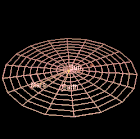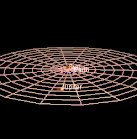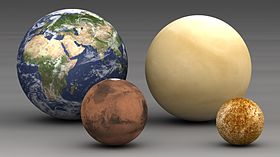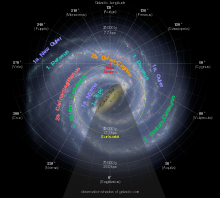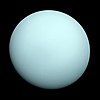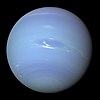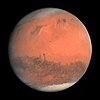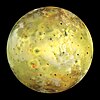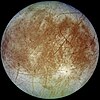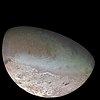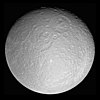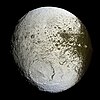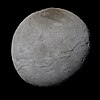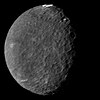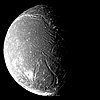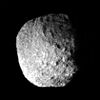Solar System
 | |
| Age | 4.568 billion years |
|---|---|
| Location | |
| System mass | 1.0014 Solar masses |
| Nearest star |
|
| Nearest known planetary system | Proxima Centauri system (4.25 ly) |
| Planetary system | |
| Semi-major axis of outer known planet (Neptune) | |
| Distance to Kuiper cliff | 50 AU |
Populations | |
| Stars | 1 (Sun) |
| Known planets | |
| Known dwarf planets | |
| Known natural satellites |
|
| Known minor planets | 796,354[a][3] |
| Known comets | 4,143[a][3] |
| Identified rounded satellites | 19 (5–6 likely in hydrostatic equilibrium) |
| Orbit about Galactic Center | |
| Invariable-to-galactic plane inclination | 60.19° (ecliptic) |
| Distance to Galactic Center | 27,000 ± 1,000 ly |
| Orbital speed | 220 km/s; 136 mps |
| Orbital period | 225–250 myr |
| Star-related properties | |
| Spectral type | G2V |
| Frost line | ≈5 AU[4] |
| Distance to heliopause | ≈120 AU |
| Hill sphere radius | ≈1–3 ly |
 |
| Objects |
|---|
| Lists |
| Planets |
|
|
The Solar System[b] is the gravitationally bound system of the Sun and the objects that orbit it, either directly or indirectly.[c] Of the objects that orbit the Sun directly, the largest are the eight planets,[d] with the remainder being smaller objects, the dwarf planets and small Solar System bodies. Of the objects that orbit the Sun indirectly—the moons—two are larger than the smallest planet, Mercury.[e]
The Solar System formed 4.6 billion years ago from the gravitational collapse of a giant interstellar molecular cloud. The vast majority of the system's mass is in the Sun, with the majority of the remaining mass contained in Jupiter. The four smaller inner planets, Mercury, Venus, Earth and Mars, are terrestrial planets, being primarily composed of rock and metal. The four outer planets are giant planets, being substantially more massive than the terrestrials. The two largest, Jupiter and Saturn, are gas giants, being composed mainly of hydrogen and helium; the two outermost planets, Uranus and Neptune, are ice giants, being composed mostly of substances with relatively high melting points compared with hydrogen and helium, called volatiles, such as water, ammonia and methane. All eight planets have almost circular orbits that lie within a nearly flat disc called the ecliptic.
The Solar System also contains smaller objects.[f] The asteroid belt, which lies between the orbits of Mars and Jupiter, mostly contains objects composed, like the terrestrial planets, of rock and metal. Beyond Neptune's orbit lie the Kuiper belt and scattered disc, which are populations of trans-Neptunian objects composed mostly of ices, and beyond them a newly discovered population of sednoids. Within these populations, some objects are large enough to have rounded under their own gravity, though there is considerable debate as to how many there will prove to be.[9][10] Such objects are categorized as dwarf planets. Identified or accepted dwarf planets include the asteroid Ceres and the trans-Neptunian objects Pluto and Eris.[f] In addition to these two regions, various other small-body populations, including comets, centaurs and interplanetary dust clouds, freely travel between regions. Six of the planets, the six largest possible dwarf planets, and many of the smaller bodies are orbited by natural satellites,[g] usually termed "moons" after the Moon. Each of the outer planets is encircled by planetary rings of dust and other small objects.
The solar wind, a stream of charged particles flowing outwards from the Sun, creates a bubble-like region in the interstellar medium known as the heliosphere. The heliopause is the point at which pressure from the solar wind is equal to the opposing pressure of the interstellar medium; it extends out to the edge of the scattered disc. The Oort cloud, which is thought to be the source for long-period comets, may also exist at a distance roughly a thousand times further than the heliosphere. The Solar System is located in the Orion Arm, 26,000 light-years from the center of the Milky Way galaxy.
Discovery and exploration

For most of history, humanity did not recognize or understand the concept of the Solar System. Most people up to the Late Middle Ages–Renaissance believed Earth to be stationary at the centre of the universe and categorically different from the divine or ethereal objects that moved through the sky. Although the Greek philosopher Aristarchus of Samos had speculated on a heliocentric reordering of the cosmos, Nicolaus Copernicus was the first to develop a mathematically predictive heliocentric system.[11][12]
In the 17th century, Galileo discovered that the Sun was marked with sunspots, and that Jupiter had four satellites in orbit around it.[13] Christiaan Huygens followed on from Galileo's discoveries by discovering Saturn's moon Titan and the shape of the rings of Saturn.[14] Edmond Halley realised in 1705 that repeated sightings of a comet were recording the same object, returning regularly once every 75–76 years. This was the first evidence that anything other than the planets orbited the Sun.[15] Around this time (1704), the term "Solar System" first appeared in English.[16] In 1838, Friedrich Bessel successfully measured a stellar parallax, an apparent shift in the position of a star created by Earth's motion around the Sun, providing the first direct, experimental proof of heliocentrism.[17] Improvements in observational astronomy and the use of unmanned spacecraft have since enabled the detailed investigation of other bodies orbiting the Sun.
Structure and composition
The principal component of the Solar System is the Sun, a G2 main-sequence star that contains 99.86% of the system's known mass and dominates it gravitationally.[18] The Sun's four largest orbiting bodies, the giant planets, account for 99% of the remaining mass, with Jupiter and Saturn together comprising more than 90%. The remaining objects of the Solar System (including the four terrestrial planets, the dwarf planets, moons, asteroids, and comets) together comprise less than 0.002% of the Solar System's total mass.[h]
Most large objects in orbit around the Sun lie near the plane of Earth's orbit, known as the ecliptic. The planets are very close to the ecliptic, whereas comets and Kuiper belt objects are frequently at significantly greater angles to it.[22][23] As a result of the formation of the Solar System planets, and most other objects, orbit the Sun in the same direction that the Sun is rotating (counter-clockwise, as viewed from above Earth's north pole).[24] There are exceptions, such as Halley's Comet. Most of the larger moons orbit their planets in this prograde direction and most larger objects rotate themselves in the same direction (with Venus being a notable retrograde exception).
The overall structure of the charted regions of the Solar System consists of the Sun, four relatively small inner planets surrounded by a belt of mostly rocky asteroids, and four giant planets surrounded by the Kuiper belt of mostly icy objects. Astronomers sometimes informally divide this structure into separate regions. The inner Solar System includes the four terrestrial planets and the asteroid belt. The outer Solar System is beyond the asteroids, including the four giant planets.[25] Since the discovery of the Kuiper belt, the outermost parts of the Solar System are considered a distinct region consisting of the objects beyond Neptune.[26]
Most of the planets in the Solar System have secondary systems of their own, being orbited by planetary objects called natural satellites, or moons (two of which, Titan and Ganymede, are larger than the planet Mercury), and, in the case of the four giant planets, by planetary rings, thin bands of tiny particles that orbit them in unison. Most of the largest natural satellites are in synchronous rotation, with one face permanently turned toward their parent.
Kepler's laws of planetary motion describe the orbits of objects about the Sun. Following Kepler's laws, each object travels along an ellipse with the Sun at one focus. Objects closer to the Sun (with smaller semi-major axes) travel more quickly because they are more affected by the Sun's gravity. On an elliptical orbit, a body's distance from the Sun varies over the course of its year. A body's closest approach to the Sun is called its perihelion, whereas its most distant point from the Sun is called its aphelion. The orbits of the planets are nearly circular, but many comets, asteroids, and Kuiper belt objects follow highly elliptical orbits. The positions of the bodies in the Solar System can be predicted using numerical models.
Although the Sun dominates the system by mass, it accounts for only about 2% of the angular momentum.[27][28] The planets, dominated by Jupiter, account for most of the rest of the angular momentum due to the combination of their mass, orbit, and distance from the Sun, with a possibly significant contribution from comets.[27]
The Sun, which comprises nearly all the matter in the Solar System, is composed of roughly 98% hydrogen and helium.[29] Jupiter and Saturn, which comprise nearly all the remaining matter, are also primarily composed of hydrogen and helium.[30][31] A composition gradient exists in the Solar System, created by heat and light pressure from the Sun; those objects closer to the Sun, which are more affected by heat and light pressure, are composed of elements with high melting points. Objects farther from the Sun are composed largely of materials with lower melting points.[32] The boundary in the Solar System beyond which those volatile substances could condense is known as the frost line, and it lies at roughly 5 AU from the Sun.[4]
The objects of the inner Solar System are composed mostly of rock,[33] the collective name for compounds with high melting points, such as silicates, iron or nickel, that remained solid under almost all conditions in the protoplanetary nebula.[34] Jupiter and Saturn are composed mainly of gases, the astronomical term for materials with extremely low melting points and high vapour pressure, such as hydrogen, helium, and neon, which were always in the gaseous phase in the nebula.[34] Ices, like water, methane, ammonia, hydrogen sulfide, and carbon dioxide,[33] have melting points up to a few hundred kelvins.[34] They can be found as ices, liquids, or gases in various places in the Solar System, whereas in the nebula they were either in the solid or gaseous phase.[34] Icy substances comprise the majority of the satellites of the giant planets, as well as most of Uranus and Neptune (the so-called "ice giants") and the numerous small objects that lie beyond Neptune's orbit.[33][35] Together, gases and ices are referred to as volatiles.[36]
Distances and scales
The distance from Earth to the Sun is 1 astronomical unit [AU] (150,000,000 km; 93,000,000 mi). For comparison, the radius of the Sun is 0.0047 AU (700,000 km). Thus, the Sun occupies 0.00001% (10−5 %) of the volume of a sphere with a radius the size of Earth's orbit, whereas Earth's volume is roughly one millionth (10−6) that of the Sun. Jupiter, the largest planet, is 5.2 astronomical units (780,000,000 km) from the Sun and has a radius of 71,000 km (0.00047 AU), whereas the most distant planet, Neptune, is 30 AU (4.5×109 km) from the Sun.
With a few exceptions, the farther a planet or belt is from the Sun, the larger the distance between its orbit and the orbit of the next nearer object to the Sun. For example, Venus is approximately 0.33 AU farther out from the Sun than Mercury, whereas Saturn is 4.3 AU out from Jupiter, and Neptune lies 10.5 AU out from Uranus. Attempts have been made to determine a relationship between these orbital distances (for example, the Titius–Bode law),[37] but no such theory has been accepted. The images at the beginning of this section show the orbits of the various constituents of the Solar System on different scales.
Some Solar System models attempt to convey the relative scales involved in the Solar System on human terms. Some are small in scale (and may be mechanical—called orreries)—whereas others extend across cities or regional areas.[38] The largest such scale model, the Sweden Solar System, uses the 110-metre (361 ft) Ericsson Globe in Stockholm as its substitute Sun, and, following the scale, Jupiter is a 7.5-metre (25-foot) sphere at Stockholm Arlanda Airport, 40 km (25 mi) away, whereas the farthest current object, Sedna, is a 10 cm (4 in) sphere in Luleå, 912 km (567 mi) away.[39][40]
If the Sun–Neptune distance is scaled to 100 metres, then the Sun would be about 3 cm in diameter (roughly two-thirds the diameter of a golf ball), the giant planets would be all smaller than about 3 mm, and Earth's diameter along with that of the other terrestrial planets would be smaller than a flea (0.3 mm) at this scale.[41]
Formation and evolution

The Solar System formed 4.568 billion years ago from the gravitational collapse of a region within a large molecular cloud.[i] This initial cloud was likely several light-years across and probably birthed several stars.[43] As is typical of molecular clouds, this one consisted mostly of hydrogen, with some helium, and small amounts of heavier elements fused by previous generations of stars. As the region that would become the Solar System, known as the pre-solar nebula,[44] collapsed, conservation of angular momentum caused it to rotate faster. The centre, where most of the mass collected, became increasingly hotter than the surrounding disc.[43] As the contracting nebula rotated faster, it began to flatten into a protoplanetary disc with a diameter of roughly 200 AU[43] and a hot, dense protostar at the centre.[45][46] The planets formed by accretion from this disc,[47] in which dust and gas gravitationally attracted each other, coalescing to form ever larger bodies. Hundreds of protoplanets may have existed in the early Solar System, but they either merged or were destroyed, leaving the planets, dwarf planets, and leftover minor bodies.

Due to their higher boiling points, only metals and silicates could exist in solid form in the warm inner Solar System close to the Sun, and these would eventually form the rocky planets of Mercury, Venus, Earth, and Mars. Because metallic elements only comprised a very small fraction of the solar nebula, the terrestrial planets could not grow very large. The giant planets (Jupiter, Saturn, Uranus, and Neptune) formed further out, beyond the frost line, the point between the orbits of Mars and Jupiter where material is cool enough for volatile icy compounds to remain solid. The ices that formed these planets were more plentiful than the metals and silicates that formed the terrestrial inner planets, allowing them to grow massive enough to capture large atmospheres of hydrogen and helium, the lightest and most abundant elements. Leftover debris that never became planets congregated in regions such as the asteroid belt, Kuiper belt, and Oort cloud. The Nice model is an explanation for the creation of these regions and how the outer planets could have formed in different positions and migrated to their current orbits through various gravitational interactions.
Within 50 million years, the pressure and density of hydrogen in the centre of the protostar became great enough for it to begin thermonuclear fusion.[49] The temperature, reaction rate, pressure, and density increased until hydrostatic equilibrium was achieved: the thermal pressure equalled the force of gravity. At this point, the Sun became a main-sequence star.[50] The main-sequence phase, from beginning to end, will last about 10 billion years for the Sun compared to around two billion years for all other phases of the Sun's pre-remnant life combined.[51] Solar wind from the Sun created the heliosphere and swept away the remaining gas and dust from the protoplanetary disc into interstellar space, ending the planetary formation process. The Sun is growing brighter; early in its main-sequence life its brightness was 70% that of what it is today.[52]
The Solar System will remain roughly as we know it today until the hydrogen in the core of the Sun has been entirely converted to helium, which will occur roughly 5 billion years from now. This will mark the end of the Sun's main-sequence life. At this time, the core of the Sun will contract with hydrogen fusion occurring along a shell surrounding the inert helium, and the energy output will be much greater than at present. The outer layers of the Sun will expand to roughly 260 times its current diameter, and the Sun will become a red giant. Because of its vastly increased surface area, the surface of the Sun will be considerably cooler (2,600 K at its coolest) than it is on the main sequence.[51] The expanding Sun is expected to vaporize Mercury and render Earth uninhabitable. Eventually, the core will be hot enough for helium fusion; the Sun will burn helium for a fraction of the time it burned hydrogen in the core. The Sun is not massive enough to commence the fusion of heavier elements, and nuclear reactions in the core will dwindle. Its outer layers will move away into space, leaving a white dwarf, an extraordinarily dense object, half the original mass of the Sun but only the size of Earth.[53] The ejected outer layers will form what is known as a planetary nebula, returning some of the material that formed the Sun—but now enriched with heavier elements like carbon—to the interstellar medium.
Sun
The Sun is the Solar System's star and by far its most massive component. Its large mass (332,900 Earth masses),[54] which comprises 99.86% of all the mass in the Solar System,[55] produces temperatures and densities in its core high enough to sustain nuclear fusion of hydrogen into helium, making it a main-sequence star.[56] This releases an enormous amount of energy, mostly radiated into space as electromagnetic radiation peaking in visible light.[57]
The Sun is a G2-type main-sequence star. Hotter main-sequence stars are more luminous. The Sun's temperature is intermediate between that of the hottest stars and that of the coolest stars. Stars brighter and hotter than the Sun are rare, whereas substantially dimmer and cooler stars, known as red dwarfs, make up 85% of the stars in the Milky Way.[58][59]
The Sun is a population I star; it has a higher abundance of elements heavier than hydrogen and helium ("metals" in astronomical parlance) than the older population II stars.[60] Elements heavier than hydrogen and helium were formed in the cores of ancient and exploding stars, so the first generation of stars had to die before the Universe could be enriched with these atoms. The oldest stars contain few metals, whereas stars born later have more. This high metallicity is thought to have been crucial to the Sun's development of a planetary system because the planets form from the accretion of "metals".[61]
Interplanetary medium
The vast majority of the Solar System consists of a near-vacuum known as the interplanetary medium. Along with light, the Sun radiates a continuous stream of charged particles (a plasma) known as the solar wind. This stream of particles spreads outwards at roughly 1.5 million kilometres per hour,[62] creating a tenuous atmosphere that permeates the interplanetary medium out to at least 100 AU (see § Heliosphere).[63] Activity on the Sun's surface, such as solar flares and coronal mass ejections, disturbs the heliosphere, creating space weather and causing geomagnetic storms.[64] The largest structure within the heliosphere is the heliospheric current sheet, a spiral form created by the actions of the Sun's rotating magnetic field on the interplanetary medium.[65][66]
Earth's magnetic field stops its atmosphere from being stripped away by the solar wind.[67] Venus and Mars do not have magnetic fields, and as a result the solar wind is causing their atmospheres to gradually bleed away into space.[68] Coronal mass ejections and similar events blow a magnetic field and huge quantities of material from the surface of the Sun. The interaction of this magnetic field and material with Earth's magnetic field funnels charged particles into Earth's upper atmosphere, where its interactions create aurorae seen near the magnetic poles.
The heliosphere and planetary magnetic fields (for those planets that have them) partially shield the Solar System from high-energy interstellar particles called cosmic rays. The density of cosmic rays in the interstellar medium and the strength of the Sun's magnetic field change on very long timescales, so the level of cosmic-ray penetration in the Solar System varies, though by how much is unknown.[69]
The interplanetary medium is home to at least two disc-like regions of cosmic dust. The first, the zodiacal dust cloud, lies in the inner Solar System and causes the zodiacal light. It was likely formed by collisions within the asteroid belt brought on by gravitational interactions with the planets.[70] The second dust cloud extends from about 10 AU to about 40 AU, and was probably created by similar collisions within the Kuiper belt.[71][72]
Inner Solar System
The inner Solar System is the region comprising the terrestrial planets and the asteroid belt.[73] Composed mainly of silicates and metals, the objects of the inner Solar System are relatively close to the Sun; the radius of this entire region is less than the distance between the orbits of Jupiter and Saturn. This region is also within the frost line, which is a little less than 5 AU (about 700 million km) from the Sun.[74]
Inner planets
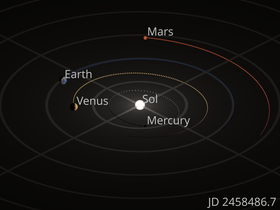
The four terrestrial or inner planets have dense, rocky compositions, few or no moons, and no ring systems. They are composed largely of refractory minerals, such as the silicates—which form their crusts and mantles—and metals, such as iron and nickel, which form their cores. Three of the four inner planets (Venus, Earth and Mars) have atmospheres substantial enough to generate weather; all have impact craters and tectonic surface features, such as rift valleys and volcanoes. The term inner planet should not be confused with inferior planet, which designates those planets that are closer to the Sun than Earth is (i.e. Mercury and Venus).
Mercury
Mercury (0.4 AU from the Sun) is the closest planet to the Sun and on average, all seven other planets.[75][76] The smallest planet in the Solar System (0.055 M⊕), Mercury has no natural satellites. Besides impact craters, its only known geological features are lobed ridges or rupes that were probably produced by a period of contraction early in its history.[77] Mercury's very tenuous atmosphere consists of atoms blasted off its surface by the solar wind.[78] Its relatively large iron core and thin mantle have not yet been adequately explained. Hypotheses include that its outer layers were stripped off by a giant impact, or that it was prevented from fully accreting by the young Sun's energy.[79][80]
Venus
Venus (0.7 AU from the Sun) is close in size to Earth (0.815 M⊕) and, like Earth, has a thick silicate mantle around an iron core, a substantial atmosphere, and evidence of internal geological activity. It is much drier than Earth, and its atmosphere is ninety times as dense. Venus has no natural satellites. It is the hottest planet, with surface temperatures over 400 °C (752 °F), most likely due to the amount of greenhouse gases in the atmosphere.[81] No definitive evidence of current geological activity has been detected on Venus, but it has no magnetic field that would prevent depletion of its substantial atmosphere, which suggests that its atmosphere is being replenished by volcanic eruptions.[82]
Earth
Earth (1 AU from the Sun) is the largest and densest of the inner planets, the only one known to have current geological activity, and the only place where life is known to exist.[83] Its liquid hydrosphere is unique among the terrestrial planets, and it is the only planet where plate tectonics has been observed. Earth's atmosphere is radically different from those of the other planets, having been altered by the presence of life to contain 21% free oxygen.[84] It has one natural satellite, the Moon, the only large satellite of a terrestrial planet in the Solar System.
Mars
Mars (1.5 AU from the Sun) is smaller than Earth and Venus (0.107 M⊕). It has an atmosphere of mostly carbon dioxide with a surface pressure of 6.1 millibars (roughly 0.6% of that of Earth).[85] Its surface, peppered with vast volcanoes, such as Olympus Mons, and rift valleys, such as Valles Marineris, shows geological activity that may have persisted until as recently as 2 million years ago.[86] Its red colour comes from iron oxide (rust) in its soil.[87] Mars has two tiny natural satellites (Deimos and Phobos) thought to be either captured asteroids,[88] or ejected debris from a massive impact early in Mars's history.[89]
Asteroid belt
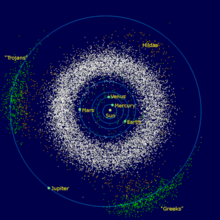
| Sun Jupiter trojans Planetary orbit | Asteroid belt Hilda asteroids NEOs (selection) |
Asteroids except for the largest, Ceres, are classified as small Solar System bodies[f] and are composed mainly of refractory rocky and metallic minerals, with some ice.[90][91] They range from a few metres to hundreds of kilometres in size. Asteroids smaller than one meter are usually called meteoroids and micrometeoroids (grain-sized), depending on different, somewhat arbitrary definitions.
The asteroid belt occupies the orbit between Mars and Jupiter, between 2.3 and 3.3 AU from the Sun. It is thought to be remnants from the Solar System's formation that failed to coalesce because of the gravitational interference of Jupiter.[92] The asteroid belt contains tens of thousands, possibly millions, of objects over one kilometre in diameter.[93] Despite this, the total mass of the asteroid belt is unlikely to be more than a thousandth of that of Earth.[21] The asteroid belt is very sparsely populated; spacecraft routinely pass through without incident.
Ceres
Ceres (2.77 AU) is the largest asteroid, a protoplanet, and a dwarf planet.[f] It has a diameter of slightly under 1000 km, and a mass large enough for its own gravity to pull it into a spherical shape. Ceres was considered a planet when it was discovered in 1801, and was reclassified to asteroid in the 1850s as further observations revealed additional asteroids.[94] It was classified as a dwarf planet in 2006 when the definition of a planet was created.
Asteroid groups
Asteroids in the asteroid belt are divided into asteroid groups and families based on their orbital characteristics. Asteroid moons are asteroids that orbit larger asteroids. They are not as clearly distinguished as planetary moons, sometimes being almost as large as their partners. The asteroid belt also contains main-belt comets, which may have been the source of Earth's water.[95]
Jupiter trojans are located in either of Jupiter's L4 or L5 points (gravitationally stable regions leading and trailing a planet in its orbit); the term trojan is also used for small bodies in any other planetary or satellite Lagrange point. Hilda asteroids are in a 2:3 resonance with Jupiter; that is, they go around the Sun three times for every two Jupiter orbits.[96]
The inner Solar System also contains near-Earth asteroids, many of which cross the orbits of the inner planets.[97] Some of them are potentially hazardous objects.
Outer Solar System
The outer region of the Solar System is home to the giant planets and their large moons. The centaurs and many short-period comets also orbit in this region. Due to their greater distance from the Sun, the solid objects in the outer Solar System contain a higher proportion of volatiles, such as water, ammonia, and methane than those of the inner Solar System because the lower temperatures allow these compounds to remain solid.
Outer planets

The four outer planets, or giant planets (sometimes called Jovian planets), collectively make up 99% of the mass known to orbit the Sun.[h] Jupiter and Saturn are together more than 400 times the mass of Earth and consist overwhelmingly of hydrogen and helium. Uranus and Neptune are far less massive—less than 20 Earth masses (M⊕) each—and are composed primarily of ices. For these reasons, some astronomers suggest they belong in their own category, ice giants.[98] All four giant planets have rings, although only Saturn's ring system is easily observed from Earth. The term superior planet designates planets outside Earth's orbit and thus includes both the outer planets and Mars.
Jupiter
Jupiter (5.2 AU), at 318 M⊕, is 2.5 times the mass of all the other planets put together. It is composed largely of hydrogen and helium. Jupiter's strong internal heat creates semi-permanent features in its atmosphere, such as cloud bands and the Great Red Spot. Jupiter has 79 known satellites. The four largest, Ganymede, Callisto, Io, and Europa, show similarities to the terrestrial planets, such as volcanism and internal heating.[99] Ganymede, the largest satellite in the Solar System, is larger than Mercury.
Saturn
Saturn (9.5 AU), distinguished by its extensive ring system, has several similarities to Jupiter, such as its atmospheric composition and magnetosphere. Although Saturn has 60% of Jupiter's volume, it is less than a third as massive, at 95 M⊕. Saturn is the only planet of the Solar System that is less dense than water.[100] The rings of Saturn are made up of small ice and rock particles. Saturn has 82 confirmed satellites composed largely of ice. Two of these, Titan and Enceladus, show signs of geological activity.[101] Titan, the second-largest moon in the Solar System, is larger than Mercury and the only satellite in the Solar System with a substantial atmosphere.
Uranus
Uranus (19.2 AU), at 14 M⊕, is the lightest of the outer planets. Uniquely among the planets, it orbits the Sun on its side; its axial tilt is over ninety degrees to the ecliptic. It has a much colder core than the other giant planets and radiates very little heat into space.[102] Uranus has 27 known satellites, the largest ones being Titania, Oberon, Umbriel, Ariel, and Miranda.
Neptune
Neptune (30.1 AU), though slightly smaller than Uranus, is more massive (17 M⊕) and hence more dense. It radiates more internal heat, but not as much as Jupiter or Saturn.[103] Neptune has 14 known satellites. The largest, Triton, is geologically active, with geysers of liquid nitrogen.[104] Triton is the only large satellite with a retrograde orbit. Neptune is accompanied in its orbit by several minor planets, termed Neptune trojans, that are in 1:1 resonance with it.
Centaurs
The centaurs are icy comet-like bodies whose orbits have semi-major axes greater than Jupiter's (5.5 AU) and less than Neptune's (30 AU). The largest known centaur, 10199 Chariklo, has a diameter of about 250 km.[105] The first centaur discovered, 2060 Chiron, has also been classified as comet (95P) because it develops a coma just as comets do when they approach the Sun.[106]
Comets
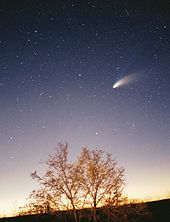
Comets are small Solar System bodies,[f] typically only a few kilometres across, composed largely of volatile ices. They have highly eccentric orbits, generally a perihelion within the orbits of the inner planets and an aphelion far beyond Pluto. When a comet enters the inner Solar System, its proximity to the Sun causes its icy surface to sublimate and ionise, creating a coma: a long tail of gas and dust often visible to the naked eye.
Short-period comets have orbits lasting less than two hundred years. Long-period comets have orbits lasting thousands of years. Short-period comets are thought to originate in the Kuiper belt, whereas long-period comets, such as Hale–Bopp, are thought to originate in the Oort cloud. Many comet groups, such as the Kreutz Sungrazers, formed from the breakup of a single parent.[107] Some comets with hyperbolic orbits may originate outside the Solar System, but determining their precise orbits is difficult.[108] Old comets that have had most of their volatiles driven out by solar warming are often categorised as asteroids.[109]
Trans-Neptunian region
Beyond the orbit of Neptune lies the area of the "trans-Neptunian region", with the doughnut-shaped Kuiper belt, home of Pluto and several other dwarf planets, and an overlapping disc of scattered objects, which is tilted toward the plane of the Solar System and reaches much further out than the Kuiper belt. The entire region is still largely unexplored. It appears to consist overwhelmingly of many thousands of small worlds—the largest having a diameter only a fifth that of Earth and a mass far smaller than that of the Moon—composed mainly of rock and ice. This region is sometimes described as the "third zone of the Solar System", enclosing the inner and the outer Solar System.[110]
Kuiper belt

| Sun Jupiter trojans Giant planets | Kuiper belt Scattered disc Neptune trojans |
The Kuiper belt is a great ring of debris similar to the asteroid belt, but consisting mainly of objects composed primarily of ice.[111] It extends between 30 and 50 AU from the Sun. Though it is estimated to contain anything from dozens to thousands of dwarf planets, it is composed mainly of small Solar System bodies. Many of the larger Kuiper belt objects, such as Quaoar, Varuna, and Orcus, may prove to be dwarf planets with further data. There are estimated to be over 100,000 Kuiper belt objects with a diameter greater than 50 km, but the total mass of the Kuiper belt is thought to be only a tenth or even a hundredth the mass of Earth.[20] Many Kuiper belt objects have multiple satellites,[112] and most have orbits that take them outside the plane of the ecliptic.[113]
The Kuiper belt can be roughly divided into the "classical" belt and the resonances.[111] Resonances are orbits linked to that of Neptune (e.g. twice for every three Neptune orbits, or once for every two). The first resonance begins within the orbit of Neptune itself. The classical belt consists of objects having no resonance with Neptune, and extends from roughly 39.4 AU to 47.7 AU.[114] Members of the classical Kuiper belt are classified as cubewanos, after the first of their kind to be discovered, 15760 Albion (which previously had the provisional designation 1992 QB1), and are still in near primordial, low-eccentricity orbits.[115]
Pluto and Charon
The dwarf planet Pluto (39 AU average) is the largest known object in the Kuiper belt. When discovered in 1930, it was considered to be the ninth planet; this changed in 2006 with the adoption of a formal definition of planet. Pluto has a relatively eccentric orbit inclined 17 degrees to the ecliptic plane and ranging from 29.7 AU from the Sun at perihelion (within the orbit of Neptune) to 49.5 AU at aphelion. Pluto has a 3:2 resonance with Neptune, meaning that Pluto orbits twice round the Sun for every three Neptunian orbits. Kuiper belt objects whose orbits share this resonance are called plutinos.[116]
Charon, the largest of Pluto's moons, is sometimes described as part of a binary system with Pluto, as the two bodies orbit a barycentre of gravity above their surfaces (i.e. they appear to "orbit each other"). Beyond Charon, four much smaller moons, Styx, Nix, Kerberos, and Hydra, orbit within the system.
Makemake and Haumea
Makemake (45.79 AU average), although smaller than Pluto, is the largest known object in the classical Kuiper belt (that is, a Kuiper belt object not in a confirmed resonance with Neptune). Makemake is the brightest object in the Kuiper belt after Pluto. It was assigned a naming committee under the expectation that it would prove to be a dwarf planet in 2008.[6] Its orbit is far more inclined than Pluto's, at 29°.[117]
Haumea (43.13 AU average) is in an orbit similar to Makemake, except that it is in a temporary 7:12 orbital resonance with Neptune.[118] It was named under the same expectation that it would prove to be a dwarf planet, though subsequent observations have indicated that it may not be a dwarf planet after all.[119]
Scattered disc
The scattered disc, which overlaps the Kuiper belt but extends out to about 200 AU, is thought to be the source of short-period comets. Scattered-disc objects are thought to have been ejected into erratic orbits by the gravitational influence of Neptune's early outward migration. Most scattered disc objects (SDOs) have perihelia within the Kuiper belt but aphelia far beyond it (some more than 150 AU from the Sun). SDOs' orbits are also highly inclined to the ecliptic plane and are often almost perpendicular to it. Some astronomers consider the scattered disc to be merely another region of the Kuiper belt and describe scattered disc objects as "scattered Kuiper belt objects".[120] Some astronomers also classify centaurs as inward-scattered Kuiper belt objects along with the outward-scattered residents of the scattered disc.[121]
Eris
Eris (68 AU average) is the largest known scattered disc object, and caused a debate about what constitutes a planet, because it is 25% more massive than Pluto[122] and about the same diameter. It is the most massive of the known dwarf planets. It has one known moon, Dysnomia. Like Pluto, its orbit is highly eccentric, with a perihelion of 38.2 AU (roughly Pluto's distance from the Sun) and an aphelion of 97.6 AU, and steeply inclined to the ecliptic plane.
Farthest regions

The point at which the Solar System ends and interstellar space begins is not precisely defined because its outer boundaries are shaped by two separate forces: the solar wind and the Sun's gravity. The limit of the solar wind's influence is roughly four times Pluto's distance from the Sun; this heliopause, the outer boundary of the heliosphere, is considered the beginning of the interstellar medium.[63] The Sun's Hill sphere, the effective range of its gravitational dominance, is thought to extend up to a thousand times farther and encompasses the theorized Oort cloud.[123]
Heliosphere

The heliosphere is a stellar-wind bubble, a region of space dominated by the Sun, which radiates at roughly 400 km/s its solar wind, a stream of charged particles, until it collides with the wind of the interstellar medium.
The collision occurs at the termination shock, which is roughly 80–100 AU from the Sun upwind of the interstellar medium and roughly 200 AU from the Sun downwind.[124] Here the wind slows dramatically, condenses and becomes more turbulent,[124] forming a great oval structure known as the heliosheath. This structure is thought to look and behave very much like a comet's tail, extending outward for a further 40 AU on the upwind side but tailing many times that distance downwind; evidence from Cassini and Interstellar Boundary Explorer spacecraft has suggested that it is forced into a bubble shape by the constraining action of the interstellar magnetic field.[125]
The outer boundary of the heliosphere, the heliopause, is the point at which the solar wind finally terminates and is the beginning of interstellar space.[63] Voyager 1 and Voyager 2 are reported to have passed the termination shock and entered the heliosheath, at 94 and 84 AU from the Sun, respectively.[126][127] Voyager 1 is reported to have crossed the heliopause in August 2012.[128]
The shape and form of the outer edge of the heliosphere is likely affected by the fluid dynamics of interactions with the interstellar medium as well as solar magnetic fields prevailing to the south, e.g. it is bluntly shaped with the northern hemisphere extending 9 AU farther than the southern hemisphere.[124] Beyond the heliopause, at around 230 AU, lies the bow shock, a plasma "wake" left by the Sun as it travels through the Milky Way.[129]
Due to a lack of data, conditions in local interstellar space are not known for certain. It is expected that NASA's Voyager spacecraft, as they pass the heliopause, will transmit valuable data on radiation levels and solar wind to Earth.[130] How well the heliosphere shields the Solar System from cosmic rays is poorly understood. A NASA-funded team has developed a concept of a "Vision Mission" dedicated to sending a probe to the heliosphere.[131][132]
Detached objects
90377 Sedna (520 AU average) is a large, reddish object with a gigantic, highly elliptical orbit that takes it from about 76 AU at perihelion to 940 AU at aphelion and takes 11,400 years to complete. Mike Brown, who discovered the object in 2003, asserts that it cannot be part of the scattered disc or the Kuiper belt because its perihelion is too distant to have been affected by Neptune's migration. He and other astronomers consider it to be the first in an entirely new population, sometimes termed "distant detached objects" (DDOs), which also may include the object 2000 CR105, which has a perihelion of 45 AU, an aphelion of 415 AU, and an orbital period of 3,420 years.[133] Brown terms this population the "inner Oort cloud" because it may have formed through a similar process, although it is far closer to the Sun.[134] Sedna is very likely a dwarf planet, though its shape has yet to be determined. The second unequivocally detached object, with a perihelion farther than Sedna's at roughly 81 AU, is 2012 VP113, discovered in 2012. Its aphelion is only half that of Sedna's, at 400–500 AU.[135][136]
Oort cloud

The Oort cloud is a hypothetical spherical cloud of up to a trillion icy objects that is thought to be the source for all long-period comets and to surround the Solar System at roughly 50,000 AU (around 1 light-year (ly)), and possibly to as far as 100,000 AU (1.87 ly). It is thought to be composed of comets that were ejected from the inner Solar System by gravitational interactions with the outer planets. Oort cloud objects move very slowly, and can be perturbed by infrequent events, such as collisions, the gravitational effects of a passing star, or the galactic tide, the tidal force exerted by the Milky Way.[137][138]
Boundaries
Much of the Solar System is still unknown. The Sun's gravitational field is estimated to dominate the gravitational forces of surrounding stars out to about two light years (125,000 AU). Lower estimates for the radius of the Oort cloud, by contrast, do not place it farther than 50,000 AU.[139] Despite discoveries such as Sedna, the region between the Kuiper belt and the Oort cloud, an area tens of thousands of AU in radius, is still virtually unmapped. There are also ongoing studies of the region between Mercury and the Sun.[140] Objects may yet be discovered in the Solar System's uncharted regions.
Currently, the furthest known objects, such as Comet West, have aphelia around 70,000 AU from the Sun, but as the Oort cloud becomes better known, this may change.
Galactic context
The Solar System is located in the Milky Way, a barred spiral galaxy with a diameter of about 100,000 light-years containing more than 100 billion stars.[141] The Sun resides in one of the Milky Way's outer spiral arms, known as the Orion–Cygnus Arm or Local Spur.[142] The Sun lies between 25,000 and 28,000 light-years from the Galactic Centre,[143] and its speed within the Milky Way is about 220 km/s, so that it completes one revolution every 225–250 million years. This revolution is known as the Solar System's galactic year.[144] The solar apex, the direction of the Sun's path through interstellar space, is near the constellation Hercules in the direction of the current location of the bright star Vega.[145] The plane of the ecliptic lies at an angle of about 60° to the galactic plane.[j]
The Solar System's location in the Milky Way is a factor in the evolutionary history of life on Earth. Its orbit is close to circular, and orbits near the Sun are at roughly the same speed as that of the spiral arms.[147][148] Therefore, the Sun passes through arms only rarely. Because spiral arms are home to a far larger concentration of supernovae, gravitational instabilities, and radiation that could disrupt the Solar System, this has given Earth long periods of stability for life to evolve.[147] The Solar System also lies well outside the star-crowded environs of the galactic centre. Near the centre, gravitational tugs from nearby stars could perturb bodies in the Oort cloud and send many comets into the inner Solar System, producing collisions with potentially catastrophic implications for life on Earth. The intense radiation of the galactic centre could also interfere with the development of complex life.[147] Even at the Solar System's current location, some scientists have speculated that recent supernovae may have adversely affected life in the last 35,000 years, by flinging pieces of expelled stellar core towards the Sun, as radioactive dust grains and larger, comet-like bodies.[149]
Neighbourhood

The Solar System is in the Local Interstellar Cloud or Local Fluff. It is thought to be near the neighbouring G-Cloud but it is not known if the Solar System is embedded in the Local Interstellar Cloud, or if it is in the region where the Local Interstellar Cloud and G-Cloud are interacting.[150][151] The Local Interstellar Cloud is an area of denser cloud in an otherwise sparse region known as the Local Bubble, an hourglass-shaped cavity in the interstellar medium roughly 300 light-years (ly) across. The bubble is suffused with high-temperature plasma, that suggests it is the product of several recent supernovae.[152]
There are relatively few stars within ten light-years of the Sun. The closest is the triple star system Alpha Centauri, which is about 4.4 light-years away. Alpha Centauri A and B are a closely tied pair of Sun-like stars, whereas the small red dwarf, Proxima Centauri, orbits the pair at a distance of 0.2 light-year. In 2016, a potentially habitable exoplanet was confirmed to be orbiting Proxima Centauri, called Proxima Centauri b, the closest confirmed exoplanet to the Sun.[153] The stars next closest to the Sun are the red dwarfs Barnard's Star (at 5.9 ly), Wolf 359 (7.8 ly), and Lalande 21185 (8.3 ly).
The largest nearby star is Sirius, a bright main-sequence star roughly 8.6 light-years away and roughly twice the Sun's mass and that is orbited by a white dwarf, Sirius B. The nearest brown dwarfs are the binary Luhman 16 system at 6.6 light-years. Other systems within ten light-years are the binary red-dwarf system Luyten 726-8 (8.7 ly) and the solitary red dwarf Ross 154 (9.7 ly).[154] The closest solitary Sun-like star to the Solar System is Tau Ceti at 11.9 light-years. It has roughly 80% of the Sun's mass but only 60% of its luminosity.[155] The closest known free-floating planetary-mass object to the Sun is WISE 0855−0714,[156] an object with a mass less than 10 Jupiter masses roughly 7 light-years away.
Comparison with extrasolar systems
Compared to many other planetary systems, the Solar System stands out in lacking planets interior to the orbit of Mercury.[157][158] The known Solar System also lacks super-Earths (Planet Nine could be a super-Earth beyond the known Solar System).[157] Uncommonly, it has only small rocky planets and large gas giants; elsewhere planets of intermediate size are typical—both rocky and gas—so there is no "gap" as seen between the size of Earth and of Neptune (with a radius 3.8 times as large). Also, these super-Earths have closer orbits than Mercury.[157] This led to the hypothesis that all planetary systems start with many close-in planets, and that typically a sequence of their collisions causes consolidation of mass into few larger planets, but in case of the Solar System the collisions caused their destruction and ejection.[159][160]
The orbits of Solar System planets are nearly circular. Compared to other systems, they have smaller orbital eccentricity.[157] Although there are attempts to explain it partly with a bias in the radial-velocity detection method and partly with long interactions of a quite high number of planets, the exact causes remain undetermined.[157][161]
Visual summary
This section is a sampling of Solar System bodies, selected for size and quality of imagery, and sorted by volume. Some omitted objects are larger than the ones included here, notably Eris, because these have not been imaged in high quality.

|
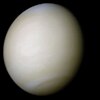
| |||||
| Sun (star) |
Jupiter (planet) |
Saturn (planet) |
Uranus (planet) |
Neptune (planet) |
Earth (planet) |
Venus (planet) |
| Mars (planet) |
Ganymede (moon of Jupiter) |
Titan (moon of Saturn) |
Mercury (planet) |
Callisto (moon of Jupiter) |
Io (moon of Jupiter) |
Moon (moon of Earth) |

|
||||||
| Europa (moon of Jupiter) |
Triton (moon of Neptune) |
Pluto (Kuiper belt object) |
Titania (moon of Uranus) |
Rhea (moon of Saturn) |
Oberon (moon of Uranus) |
Iapetus (moon of Saturn) |
| Charon (moon of Pluto) |
Umbriel (moon of Uranus) |
Ariel (moon of Uranus) |
Dione (moon of Saturn) |
Tethys (moon of Saturn) |
Ceres (belt asteroid) |
Vesta (belt asteroid) |
| Pallas (belt asteroid) |
Enceladus (moon of Saturn) |
Miranda (moon of Uranus) |
Proteus (moon of Neptune) |
Mimas (moon of Saturn) |
Hyperion (moon of Saturn) |
Iris (belt asteroid) |
| Phoebe (moon of Saturn) |
Janus (moon of Saturn) |
Epimetheus (moon of Saturn) |
Lutetia (belt asteroid) |
Prometheus (moon of Saturn) |
Pandora (moon of Saturn) |
Mathilde (belt asteroid) |
| Helene (moon of Saturn) |
Ida (belt asteroid) |
Arrokoth (Kuiper Belt object) |
Phobos (moon of Mars) |
Deimos (moon of Mars) |
Churyumov– Gerasimenko (comet) |
Hartley 2 (comet) |
| Voyager 1 views the Solar System from over 6 billion km from Earth. |
|---|

Venus, Earth (Pale Blue Dot), Jupiter, Saturn, Uranus, Neptune (13 September 1996). |
See also
- Astronomical symbols
- Earth phase
- Ephemeris is a compilation of positions of naturally occurring astronomical objects as well as artificial satellites in the sky at a given time or times.
- HIP 11915 (a solar analog whose planets contains a Jupiter analog)
- Lists of geological features of the Solar System
- List of gravitationally rounded objects of the Solar System
- List of Solar System extremes
- List of Solar System objects by size
- Outline of the Solar System
- Planetary mnemonic
- Solar System in fiction
- Solar System models
Notes
- ^ a b As of August 27, 2019.
- ^ Capitalization of the name varies. The International Astronomical Union, the authoritative body regarding astronomical nomenclature, specifies capitalizing the names of all individual astronomical objects, but uses mixed "Solar System" and "solar system" in their naming guidelines document. The name is commonly rendered in lower case ("solar system"), as, for example, in the Oxford English Dictionary and Merriam-Webster's 11th Collegiate Dictionary.
- ^ The natural satellites (moons) orbiting the Solar System's planets are an example of the latter.
- ^ Historically, several other bodies were once considered planets, including, from its discovery in 1930 until 2006, Pluto. See Former planets.
- ^ The two moons larger than Mercury are Ganymede, which orbits Jupiter, and Titan, which orbits Saturn. Although bigger than Mercury, both moons have less than half its mass. In addition, the radius of Jupiter's moon Callisto is over 98% that of Mercury.
- ^ a b c d e According to IAU definitions, objects orbiting the Sun are classified dynamically and physically into three categories: planets, dwarf planets, and small Solar System bodies.
- A planet is any body orbiting the Sun whose mass is sufficient for gravity to have pulled it into a (near-)spherical shape and that has cleared its immediate neighbourhood of all smaller objects. By this definition, the Solar System has eight planets: Mercury, Venus, Earth, Mars, Jupiter, Saturn, Uranus, and Neptune. Because it has not cleared its neighbourhood of other Kuiper belt objects, Pluto does not fit this definition.[5]
- A dwarf planet is a body orbiting the Sun that is massive enough to be made near-spherical by its own gravity but that has not cleared planetesimals from its neighbourhood and is also not a satellite.[5] Pluto is a dwarf planet and the IAU has recognized or named four other bodies in the Solar System under the expectation that they will turn out to be dwarf planets: Ceres, Haumea, Makemake, and Eris.[6] Other objects commonly expected to be dwarf planets include Gonggong, Sedna, Orcus, and Quaoar.[7] In a reference to Pluto, other dwarf planets orbiting in the trans-Neptunian region are sometimes called "plutoids",[8] though this term is seldom used.
- The remaining objects orbiting the Sun are known as small Solar System bodies.[5]
- ^ See List of natural satellites of the Solar System for the full list of natural satellites of the eight planets and largest possible dwarf planets
- ^ a b The mass of the Solar System excluding the Sun, Jupiter and Saturn can be determined by adding together all the calculated masses for its largest objects and using rough calculations for the masses of the Oort cloud (estimated at roughly 3 Earth masses),[19] the Kuiper belt (estimated at roughly 0.1 Earth mass)[20] and the asteroid belt (estimated to be 0.0005 Earth mass)[21] for a total, rounded upwards, of ~37 Earth masses, or 8.1% of the mass in orbit around the Sun. With the combined masses of Uranus and Neptune (~31 Earth masses) subtracted, the remaining ~6 Earth masses of material comprise 1.3% of the total orbiting mass.
- ^ The date is based on the oldest inclusions found to date in meteorites, 4568.2+0.2
−0.4 million years, and is thought to be the date of the formation of the first solid material in the collapsing nebula.[42] - ^ If is the angle between the north pole of the ecliptic and the north galactic pole then:
where = 27° 07′ 42.01″ and = 12h 51m 26.282 are the declination and right ascension of the north galactic pole,[146] whereas = 66° 33′ 38.6″ and = 18h 0m 00 are those for the north pole of the ecliptic. (Both pairs of coordinates are for J2000 epoch.) The result of the calculation is 60.19°.
References
- ^ "How Many Solar System Bodies". NASA/JPL Solar System Dynamics. Retrieved 20 April 2018.
- ^ Wm. Robert Johnston (15 September 2019). "Asteroids with Satellites". Johnston's Archive. Retrieved 28 September 2019.
- ^ a b "Latest Published Data". The International Astronomical Union Minor Planet Center. Retrieved 28 September 2019.
- ^ a b Mumma, M.J.; Disanti, M.A.; Dello Russo, N.; Magee-Sauer, K.; Gibb, E.; Novak, R. (2003). "Remote infrared observations of parent volatiles in comets: A window on the early solar system". Advances in Space Research. 31 (12): 2563–2575. Bibcode:2003AdSpR..31.2563M. CiteSeerX 10.1.1.575.5091. doi:10.1016/S0273-1177(03)00578-7.
- ^ a b c "The Final IAU Resolution on the definition of "planet" ready for voting". IAU. 24 August 2006. Archived from the original on 7 January 2009. Retrieved 2 March 2007.
- ^ a b "Dwarf Planets and their Systems". Working Group for Planetary System Nomenclature (WGPSN). U.S. Geological Survey. 7 November 2008. Retrieved 13 July 2008.
- ^ Ron Ekers. "IAU Planet Definition Committee". International Astronomical Union. Archived from the original on 3 June 2009. Retrieved 13 October 2008.
- ^ "Plutoid chosen as name for Solar System objects like Pluto". International Astronomical Union, Paris. 11 June 2008. Archived from the original on 13 June 2008. Retrieved 11 June 2008.
- ^ Grundy, W.M.; Noll, K.S.; Buie, M.W.; Benecchi, S.D.; Ragozzine, D.; Roe, H.G. (December 2018). "The Mutual Orbit, Mass, and Density of Transneptunian Binary Gǃkúnǁʼhòmdímà ((229762) 2007 UK126)" (PDF). Icarus. 334: 30–38. doi:10.1016/j.icarus.2018.12.037. Archived from the original on 7 April 2019.
- ^ Mike Brown (23 August 2011). "Free the dwarf planets!". Mike Brown's Planets.
- ^ WC Rufus (1923). "The astronomical system of Copernicus". Popular Astronomy. Vol. 31. p. 510. Bibcode:1923PA.....31..510R.
- ^ Weinert, Friedel (2009). Copernicus, Darwin, & Freud: revolutions in the history and philosophy of science. Wiley-Blackwell. p. 21. ISBN 978-1-4051-8183-9.
- ^ Eric W. Weisstein (2006). "Galileo Galilei (1564–1642)". Wolfram Research. Retrieved 27 October 2010.
- ^ "Discoverer of Titan: Christiaan Huygens". ESA Space Science. 2005. Retrieved 27 October 2010.
- ^ "Comet Halley". University of Tennessee. Retrieved 27 December 2006.
- ^ "Etymonline: Solar System". Retrieved 24 January 2008.
- ^ "1838: Friedrich Bessel Measures Distance to a Star". Observatories of the Carnegie Institution for Science. Retrieved 22 September 2018.
- ^ M Woolfson (2000). "The origin and evolution of the solar system". Astronomy & Geophysics. 41 (1): 1.12–1.19. Bibcode:2000A&G....41a..12W. doi:10.1046/j.1468-4004.2000.00012.x.
- ^ Alessandro Morbidelli (2005). "Origin and dynamical evolution of comets and their reservoirs". arXiv:astro-ph/0512256.
- ^ a b Audrey Delsanti & David Jewitt (2006). "The Solar System Beyond The Planets" (PDF). Institute for Astronomy, University of Hawaii. Archived from the original (PDF) on 29 January 2007. Retrieved 3 January 2007.
- ^ a b Krasinsky, G.A.; Pitjeva, E.V.; Vasilyev, M.V.; Yagudina, E.I. (July 2002). "Hidden Mass in the Asteroid Belt". Icarus. 158 (1): 98–105. Bibcode:2002Icar..158...98K. doi:10.1006/icar.2002.6837.
- ^ Levison, H.F.; Morbidelli, A. (27 November 2003). "The formation of the Kuiper belt by the outward transport of bodies during Neptune's migration". Nature. 426 (6965): 419–421. Bibcode:2003Natur.426..419L. doi:10.1038/nature02120. PMID 14647375.
- ^ Harold F. Levison; Martin J Duncan (1997). "From the Kuiper Belt to Jupiter-Family Comets: The Spatial Distribution of Ecliptic Comets". Icarus. 127 (1): 13–32. Bibcode:1997Icar..127...13L. doi:10.1006/icar.1996.5637.
- ^ Grossman, Lisa (13 August 2009). "Planet found orbiting its star backwards for first time". New Scientist. Retrieved 10 October 2009.
- ^ "The Solar System". Nine Planets. Retrieved 15 February 2007.
- ^ Amir Alexander (2006). "New Horizons Set to Launch on 9-Year Voyage to Pluto and the Kuiper Belt". The Planetary Society. Archived from the original on 22 February 2006. Retrieved 8 November 2006.
- ^ a b Marochnik, L. & Mukhin, L. (1995). "Is Solar System Evolution Cometary Dominated?". In Shostak, G.S. (ed.). Progress in the Search for Extraterrestrial Life. Astronomical Society of the Pacific Conference Series. 74. p. 83. Bibcode:1995ASPC...74...83M. ISBN 0-937707-93-7.
- ^ Bi, S.L.; Li, T.D.; Li, L.H.; Yang, W.M. (2011). "Solar Models with Revised Abundance". The Astrophysical Journal. 731 (2): L42. arXiv:1104.1032. Bibcode:2011ApJ...731L..42B. doi:10.1088/2041-8205/731/2/L42.
- ^ "The Sun's Vital Statistics". Stanford Solar Center. Retrieved 29 July 2008., citing Eddy, J. (1979). A New Sun: The Solar Results From Skylab. NASA. p. 37. NASA SP-402.
- ^ Williams, David R. (7 September 2006). "Saturn Fact Sheet". NASA. Archived from the original on 4 August 2011. Retrieved 31 July 2007.
- ^ Williams, David R. (16 November 2004). "Jupiter Fact Sheet". NASA. Archived from the original on 26 September 2011. Retrieved 8 August 2007.
- ^ Paul Robert Weissman; Torrence V. Johnson (2007). Encyclopedia of the solar system. Academic Press. p. 615. ISBN 978-0-12-088589-3.
- ^ a b c Podolak, M.; Weizman, A.; Marley, M. (December 1995). "Comparative models of Uranus and Neptune". Planetary and Space Science. 43 (12): 1517–1522. Bibcode:1995P&SS...43.1517P. doi:10.1016/0032-0633(95)00061-5.
- ^ a b c d Podolak, M.; Podolak, J.I.; Marley, M.S. (February 2000). "Further investigations of random models of Uranus and Neptune". Planetary and Space Science. 48 (2–3): 143–151. Bibcode:2000P&SS...48..143P. doi:10.1016/S0032-0633(99)00088-4.
- ^ Michael Zellik (2002). Astronomy: The Evolving Universe (9th ed.). Cambridge University Press. p. 240. ISBN 978-0-521-80090-7. OCLC 223304585.
- ^ Placxo, Kevin W.; Gross, Michael (2006). Astrobiology: a brief introduction. JHU Press. p. 66. ISBN 978-0-8018-8367-5.
- ^ "Dawn: A Journey to the Beginning of the Solar System". Space Physics Center: UCLA. 2005. Archived from the original on 24 May 2012. Retrieved 3 November 2007.
- ^ Guy Ottewell (1989). "The Thousand-Yard Model |subtitle Earth as a Peppercorn". NOAO Educational Outreach Office. Retrieved 10 May 2012.
- ^ "Tours of Model Solar Systems". University of Illinois. Archived from the original on 12 April 2011. Retrieved 10 May 2012.
- ^ "Luleå är Sedna. I alla fall om vår sol motsvaras av Globen i Stockholm". Norrbotten Kuriren (in Swedish). Archived from the original on 15 July 2010. Retrieved 10 May 2010.
- ^ See, for example, Office of Space Science (9 July 2004). "Solar System Scale". NASA Educator Features. Retrieved 2 April 2013.
- ^ Bouvier, A.; Wadhwa, M. (2010). "The age of the Solar System redefined by the oldest Pb–Pb age of a meteoritic inclusion". Nature Geoscience. 3 (9): 637–641. Bibcode:2010NatGe...3..637B. doi:10.1038/NGEO941.
- ^ a b c "Lecture 13: The Nebular Theory of the origin of the Solar System". University of Arizona. Retrieved 27 December 2006.
- ^ Irvine, W.M. (1983). "The chemical composition of the pre-solar nebula". Cometary exploration; Proceedings of the International Conference. 1. p. 3. Bibcode:1983coex....1....3I.
- ^ Greaves, Jane S. (7 January 2005). "Disks Around Stars and the Growth of Planetary Systems". Science. 307 (5706): 68–71. Bibcode:2005Sci...307...68G. doi:10.1126/science.1101979. PMID 15637266.
- ^ Present Understanding of the Origin of Planetary Systems. National Academy of Sciences. 5 April 2000. doi:10.17226/1732. ISBN 978-0-309-04193-5. Retrieved 19 January 2007.
- ^ Boss, A.P.; Durisen, R.H. (2005). "Chondrule-forming Shock Fronts in the Solar Nebula: A Possible Unified Scenario for Planet and Chondrite Formation". The Astrophysical Journal. 621 (2): L137. arXiv:astro-ph/0501592. Bibcode:2005ApJ...621L.137B. doi:10.1086/429160.
- ^ Bartels, Meghan (18 March 2019). "NASA's New Horizons Reveals Geologic 'Frankenstein' That Formed Ultima Thule". Space.com. Retrieved 18 March 2019.
- ^ Sukyoung Yi; Pierre Demarque; Yong-Cheol Kim; Young-Wook Lee; Chang H. Ree; Thibault Lejeune; Sydney Barnes (2001). "Toward Better Age Estimates for Stellar Populations: The Y2 Isochrones for Solar Mixture". Astrophysical Journal Supplement. 136 (2): 417–437. arXiv:astro-ph/0104292. Bibcode:2001ApJS..136..417Y. doi:10.1086/321795.
- ^ A. Chrysostomou; P.W. Lucas (2005). "The Formation of Stars". Contemporary Physics. 46 (1): 29–40. Bibcode:2005ConPh..46...29C. doi:10.1080/0010751042000275277.
- ^ a b Schröder, K.-P.; Connon Smith, Robert (May 2008). "Distant future of the Sun and Earth revisited". Monthly Notices of the Royal Astronomical Society. 386 (1): 155–163. arXiv:0801.4031. Bibcode:2008MNRAS.386..155S. doi:10.1111/j.1365-2966.2008.13022.x.
- ^ Nir J. Shaviv (2003). "Towards a Solution to the Early Faint Sun Paradox: A Lower Cosmic Ray Flux from a Stronger Solar Wind". Journal of Geophysical Research. 108 (A12): 1437. arXiv:astroph/0306477. Bibcode:2003JGRA..108.1437S. doi:10.1029/2003JA009997.
- ^ Pogge, Richard W. (1997). "The Once & Future Sun". New Vistas in Astronomy. Archived from the original on 27 May 2005. Retrieved 7 December 2005.
- ^ "Sun: Facts & Figures". NASA. Archived from the original on 2 January 2008. Retrieved 14 May 2009.
- ^ Woolfson, M. (2000). "The origin and evolution of the solar system". Astronomy & Geophysics. 41 (1): 12. Bibcode:2000A&G....41a..12W. doi:10.1046/j.1468-4004.2000.00012.x.CS1 maint: ref=harv (link)
- ^ Zirker, Jack B. (2002). Journey from the Center of the Sun. Princeton University Press. pp. 120–127. ISBN 978-0-691-05781-1.
- ^ "Why is visible light visible, but not other parts of the spectrum?". The Straight Dome. 2003. Retrieved 14 May 2009.
- ^ Than, Ker (30 January 2006). "Astronomers Had it Wrong: Most Stars are Single". SPACE.com. Retrieved 1 August 2007.
- ^ Smart, R. L.; Carollo, D.; Lattanzi, M. G.; McLean, B.; Spagna, A. (2001). "The Second Guide Star Catalogue and Cool Stars". In Hugh R.A. Jones; Iain A. Steele (eds.). Ultracool Dwarfs: New Spectral Types L and T. Springer. p. 119. Bibcode:2001udns.conf..119S.
- ^ T.S. van Albada; Norman Baker (1973). "On the Two Oosterhoff Groups of Globular Clusters". The Astrophysical Journal. 185: 477–498. Bibcode:1973ApJ...185..477V. doi:10.1086/152434.
- ^ Charles H. Lineweaver (9 March 2001). "An Estimate of the Age Distribution of Terrestrial Planets in the Universe: Quantifying Metallicity as a Selection Effect". Icarus. 151 (2): 307–313. arXiv:astro-ph/0012399. Bibcode:2001Icar..151..307L. CiteSeerX 10.1.1.254.7940. doi:10.1006/icar.2001.6607.
- ^ "Solar Physics: The Solar Wind". Marshall Space Flight Center. 16 July 2006. Retrieved 3 October 2006.
- ^ a b c "Voyager Enters Solar System's Final Frontier". NASA. Retrieved 2 April 2007.
- ^ Phillips, Tony (15 February 2001). "The Sun Does a Flip". NASA–Science News. Archived from the original on 12 May 2009. Retrieved 4 February 2007.
- ^ "A Star with two North Poles". NASA–Science News. 22 April 2003. Archived from the original on 18 July 2009.
- ^ Riley, Pete (2002). "Modeling the heliospheric current sheet: Solar cycle variations" (PDF). Journal of Geophysical Research. 107. Bibcode:2002JGRA.107g.SSH8R. doi:10.1029/2001JA000299. Archived from the original (PDF) on 14 August 2009.
- ^ "Solar Wind blows some of Earth's atmosphere into space". Science@NASA Headline News. 8 December 1998.
- ^ Lundin, Richard (9 March 2001). "Erosion by the Solar Wind". Science. 291 (5510): 1909. doi:10.1126/science.1059763. PMID 11245195.
- ^ Langner, U.W.; M.S. Potgieter (2005). "Effects of the position of the solar wind termination shock and the heliopause on the heliospheric modulation of cosmic rays". Advances in Space Research. 35 (12): 2084–2090. Bibcode:2005AdSpR..35.2084L. doi:10.1016/j.asr.2004.12.005.
- ^ "Long-term Evolution of the Zodiacal Cloud". 1998. Archived from the original on 29 September 2006. Retrieved 3 February 2007.
- ^ "ESA scientist discovers a way to shortlist stars that might have planets". ESA Science and Technology. 2003. Retrieved 3 February 2007.
- ^ Landgraf, M.; Liou, J.-C.; Zook, H.A.; Grün, E. (May 2002). "Origins of Solar System Dust beyond Jupiter" (PDF). The Astronomical Journal. 123 (5): 2857–2861. arXiv:astro-ph/0201291. Bibcode:2002AJ....123.2857L. doi:10.1086/339704. Retrieved 9 February 2007.
- ^ "Inner Solar System". NASA Science (Planets). Archived from the original on 11 May 2009. Retrieved 9 May 2009.
- ^ "Frost line or snow line or ice line in the solar system". Astronoo. Archived from the original on 20 March 2015. Retrieved 28 November 2017.
- ^ Ryan Whitwam (18 March 2019). "Mercury Is Actually the Closest Planet to Every Other Planet". ExtremeTech.com. Retrieved 25 March 2019.
- ^ Mercury is the closest planet to all seven other planets on YouTube
- ^ Schenk P., Melosh H.J. (1994), Lobate Thrust Scarps and the Thickness of Mercury's Lithosphere, Abstracts of the 25th Lunar and Planetary Science Conference, 1994LPI....25.1203S
- ^ Bill Arnett (2006). "Mercury". Nine Planets. Retrieved 14 September 2006.
- ^ Benz, W.; Slattery, W.L.; Cameron, A.G.W. (1988). "Collisional stripping of Mercury's mantle". Icarus (Submitted manuscript). 74 (3): 516–528. Bibcode:1988Icar...74..516B. doi:10.1016/0019-1035(88)90118-2.
- ^ Cameron, A.G.W. (1985). "The partial volatilization of Mercury". Icarus. 64 (2): 285–294. Bibcode:1985Icar...64..285C. doi:10.1016/0019-1035(85)90091-0.
- ^ Mark Alan Bullock (1997). The Stability of Climate on Venus (PDF) (PhD). Southwest Research Institute. Archived from the original (PDF) on 14 June 2007. Retrieved 26 December 2006.
- ^ Paul Rincon (1999). "Climate Change as a Regulator of Tectonics on Venus" (PDF). Johnson Space Center Houston, TX, Institute of Meteoritics, University of New Mexico, Albuquerque, NM. Archived from the original (PDF) on 14 June 2007. Retrieved 19 November 2006.
- ^ "What are the characteristics of the Solar System that lead to the origins of life?". NASA Science (Big Questions). Retrieved 30 August 2011.
- ^ Anne E. Egger. "Earth's Atmosphere: Composition and Structure". VisionLearning.com. Archived from the original on 21 February 2007. Retrieved 26 December 2006.
- ^ David C. Gatling; Conway Leovy (2007). "Mars Atmosphere: History and Surface Interactions". In Lucy-Ann McFadden; et al. (eds.). Encyclopaedia of the Solar System. pp. 301–314.
- ^ David Noever (2004). "Modern Martian Marvels: Volcanoes?". NASA Astrobiology Magazine. Retrieved 23 July 2006.
- ^ "Mars: A Kid's Eye View". NASA. Retrieved 14 May 2009.
- ^ Scott S. Sheppard; David Jewitt & Jan Kleyna (2004). "A Survey for Outer Satellites of Mars: Limits to Completeness" (PDF). Astronomical Journal. Retrieved 26 December 2006.
- ^ Pascal Rosenblatt; Sébastien Charnoz; Kevin M. Dunseath; Mariko Terao-Dunseath; Antony Trinh; Ryuki Hyodo; Hidenori Genda; Stéven Toupin (2016). "Accretion of Phobos and Deimos in an extended debris disc stirred by transient moons" (PDF). Nature Geoscience. 9 (8): 581. Bibcode:2016NatGe...9..581R. doi:10.1038/ngeo2742.
- ^ "IAU Planet Definition Committee". International Astronomical Union. 2006. Archived from the original on 3 June 2009. Retrieved 1 March 2009.
- ^ "Are Kuiper Belt Objects asteroids? Are large Kuiper Belt Objects planets?". Cornell University. Archived from the original on 3 January 2009. Retrieved 1 March 2009.
- ^ Petit, J.-M.; Morbidelli, A.; Chambers, J. (2001). "The Primordial Excitation and Clearing of the Asteroid Belt" (PDF). Icarus. 153 (2): 338–347. Bibcode:2001Icar..153..338P. doi:10.1006/icar.2001.6702. Retrieved 22 March 2007.
- ^ "New study reveals twice as many asteroids as previously believed". ESA. 2002. Retrieved 23 June 2006.
- ^ "History and Discovery of Asteroids" (DOC). NASA. Retrieved 29 August 2006.
- ^ Phil Berardelli (2006). "Main-Belt Comets May Have Been Source of Earths Water". SpaceDaily. Retrieved 23 June 2006.
- ^ Barucci, M. A.; Kruikshank, D.P.; Mottola S.; Lazzarin M. (2002). "Physical Properties of Trojan and Centaur Asteroids". Asteroids III. Tucson, Arizona: University of Arizona Press. pp. 273–87.
- ^ Morbidelli, A.; Bottke, W.F.; Froeschlé, Ch.; Michel, P. (January 2002). W.F. Bottke Jr.; A. Cellino; P. Paolicchi; R.P. Binzel (eds.). "Origin and Evolution of Near-Earth Objects" (PDF). Asteroids III: 409–422. Bibcode:2002aste.book..409M.
- ^ Jack J. Lissauer; David J. Stevenson (2006). "Formation of Giant Planets" (PDF). NASA Ames Research Center; California Institute of Technology. Archived from the original (PDF) on 26 March 2009. Retrieved 16 January 2006.
- ^ Pappalardo, R T (1999). "Geology of the Icy Galilean Satellites: A Framework for Compositional Studies". Brown University. Archived from the original on 30 September 2007. Retrieved 16 January 2006.
- ^ "Saturn – The Most Beautiful Planet of our solar system". Preserve Articles. 23 January 2011. Archived from the original on 20 January 2012. Retrieved 24 July 2011.
- ^ Kargel, J.S. (1994). "Cryovolcanism on the icy satellites". Earth, Moon, and Planets (Submitted manuscript). 67 (1–3): 101–113. Bibcode:1995EM&P...67..101K. doi:10.1007/BF00613296.
- ^ Hawksett, David; Longstaff, Alan; Cooper, Keith; Clark, Stuart (2005). "10 Mysteries of the Solar System". Astronomy Now. 19 (8): 65. Bibcode:2005AsNow..19h..65H.
- ^ Podolak, M.; Reynolds, R.T.; Young, R. (1990). "Post Voyager comparisons of the interiors of Uranus and Neptune". Geophysical Research Letters (Submitted manuscript). 17 (10): 1737–1740. Bibcode:1990GeoRL..17.1737P. doi:10.1029/GL017i010p01737.
- ^ Duxbury, N.S.; Brown, R.H. (1995). "The Plausibility of Boiling Geysers on Triton". Beacon eSpace. Archived from the original on 26 April 2009. Retrieved 16 January 2006.
- ^ John Stansberry; Will Grundy; Mike Brown; Dale Cruikshank; John Spencer; David Trilling; Jean-Luc Margot (2007). "Physical Properties of Kuiper Belt and Centaur Objects: Constraints from Spitzer Space Telescope". The Solar System Beyond Neptune. p. 161. arXiv:astro-ph/0702538. Bibcode:2008ssbn.book..161S.
- ^ Patrick Vanouplines (1995). "Chiron biography". Vrije Universitiet Brussel. Archived from the original on 2 May 2009. Retrieved 23 June 2006.
- ^ Sekanina, Zdeněk (2001). "Kreutz sungrazers: the ultimate case of cometary fragmentation and disintegration?". Publications of the Astronomical Institute of the Academy of Sciences of the Czech Republic. 89: 78–93. Bibcode:2001PAICz..89...78S.
- ^ Królikowska, M. (2001). "A study of the original orbits of hyperbolic comets". Astronomy & Astrophysics. 376 (1): 316–324. Bibcode:2001A&A...376..316K. doi:10.1051/0004-6361:20010945.
- ^ Whipple, Fred L. (1992). "The activities of comets related to their aging and origin". Celestial Mechanics and Dynamical Astronomy. 54 (1–3): 1–11. Bibcode:1992CeMDA..54....1W. doi:10.1007/BF00049540.
- ^ Alan Stern (February 2015). "Journey to the Solar System's Third Zone". American Scientist. Retrieved 26 October 2018.
- ^ a b Stephen C. Tegler (2007). "Kuiper Belt Objects: Physical Studies". In Lucy-Ann McFadden; et al. (eds.). Encyclopedia of the Solar System. pp. 605–620.
- ^ Brown, M.E.; Van Dam, M.A.; Bouchez, A.H.; Le Mignant, D.; Campbell, R.D.; Chin, J.C.Y.; Conrad, A.; Hartman, S.K.; Johansson, E.M.; Lafon, R.E.; Rabinowitz, D.L. Rabinowitz; Stomski, P.J., Jr.; Summers, D.M.; Trujillo, C.A.; Wizinowich, P.L. (2006). "Satellites of the Largest Kuiper Belt Objects" (PDF). The Astrophysical Journal. 639 (1): L43–L46. arXiv:astro-ph/0510029. Bibcode:2006ApJ...639L..43B. doi:10.1086/501524. Retrieved 19 October 2011.
- ^ Chiang, E.I.; Jordan, A.B.; Millis, R.L.; Buie, M.W.; Wasserman, L.H.; Elliot, J.L.; Kern, S.D.; Trilling, D.E.; Meech, K.J.; et al. (2003). "Resonance Occupation in the Kuiper Belt: Case Examples of the 5:2 and Trojan Resonances" (PDF). The Astronomical Journal. 126 (1): 430–443. arXiv:astro-ph/0301458. Bibcode:2003AJ....126..430C. doi:10.1086/375207. Retrieved 15 August 2009.
- ^ M.W. Buie; R.L. Millis; L. H. Wasserman; J.L. Elliot; S.D. Kern; K.B. Clancy; E.I. Chiang; A.B. Jordan; K.J. Meech; R.M. Wagner; D.E. Trilling (2005). "Procedures, Resources and Selected Results of the Deep Ecliptic Survey". Earth, Moon, and Planets. 92 (1): 113–124. arXiv:astro-ph/0309251. Bibcode:2003EM&P...92..113B. doi:10.1023/B:MOON.0000031930.13823.be.
- ^ E. Dotto1; M. A. Barucci2; M. Fulchignoni (24 August 2006). "Beyond Neptune, the new frontier of the Solar System" (PDF). Retrieved 26 December 2006.
- ^ Fajans, J.; L. Frièdland (October 2001). "Autoresonant (nonstationary) excitation of pendulums, Plutinos, plasmas, and other nonlinear oscillators" (PDF). American Journal of Physics. 69 (10): 1096–1102. Bibcode:2001AmJPh..69.1096F. doi:10.1119/1.1389278. Archived from the original (PDF) on 7 June 2011. Retrieved 26 December 2006.
- ^ Marc W. Buie (5 April 2008). "Orbit Fit and Astrometric record for 136472". SwRI (Space Science Department). Retrieved 15 July 2012.
- ^ Michael E. Brown. "The largest Kuiper belt objects" (PDF). Caltech. Retrieved 15 July 2012.
- ^ Ortiz, J. L.; Santos-Sanz, P.; Sicardy, B.; et al. (2017). "The size, shape, density and ring of the dwarf planet Haumea from a stellar occultation". Nature. 550 (7675): 219–223. Bibcode:2017Natur.550..219O. doi:10.1038/nature24051. hdl:10045/70230. PMID 29022593.
- ^ David Jewitt (2005). "The 1000 km Scale KBOs". University of Hawaii. Retrieved 16 July 2006.
- ^ "List of Centaurs and Scattered-Disk Objects". IAU: Minor Planet Center. Retrieved 2 April 2007.
- ^ Brown, Michael E.; Schaller, Emily L. (15 June 2007). "The Mass of Dwarf Planet Eris". Science. 316 (5831): 1585. Bibcode:2007Sci...316.1585B. doi:10.1126/science.1139415. PMID 17569855.CS1 maint: ref=harv (link)
- ^ Littmann, Mark (2004). Planets Beyond: Discovering the Outer Solar System. Courier Dover Publications. pp. 162–163. ISBN 978-0-486-43602-9.
- ^ a b c Fahr, H. J.; Kausch, T.; Scherer, H. (2000). "A 5-fluid hydrodynamic approach to model the Solar System-interstellar medium interaction" (PDF). Astronomy & Astrophysics. 357: 268. Bibcode:2000A&A...357..268F. Archived from the original (PDF) on 8 August 2017. Retrieved 24 August 2008. See Figures 1 and 2.
- ^ "Cassini's Big Sky: The View from the Center of Our Solar System". NASA/JPL. 2009. Archived from the original on 6 February 2012. Retrieved 20 December 2009.
- ^ Stone, E.C.; Cummings, A.C.; McDonald, F.B.; Heikkila, B.C.; Lal, N.; Webber, W.R. (September 2005). "Voyager 1 explores the termination shock region and the heliosheath beyond". Science. 309 (5743): 2017–20. Bibcode:2005Sci...309.2017S. doi:10.1126/science.1117684. PMID 16179468.
- ^ Stone, E.C.; Cummings, A.C.; McDonald, F.B.; Heikkila, B.C.; Lal, N.; Webber, W.R. (July 2008). "An asymmetric solar wind termination shock". Nature. 454 (7200): 71–4. Bibcode:2008Natur.454...71S. doi:10.1038/nature07022. PMID 18596802.
- ^ Cook, Jia-Rui C.; Agle, D. C.; Brown, Dwayne (12 September 2013). "NASA Spacecraft Embarks on Historic Journey into Interstellar Space". NASA. Retrieved 12 September 2013.
- ^ Nemiroff, R.; Bonnell, J., eds. (24 June 2002). "The Sun's Heliosphere & Heliopause". Astronomy Picture of the Day. NASA. Retrieved 23 June 2006.
- ^ "Voyager: Interstellar Mission". NASA Jet Propulsion Laboratory. 2007. Retrieved 8 May 2008.
- ^ R. L. McNutt, Jr.; et al. (2006). "Innovative Interstellar Explorer" (PDF). Physics of the Inner Heliosheath: Voyager Observations, Theory, and Future Prospects. AIP Conference Proceedings. 858. pp. 341–347. Bibcode:2006AIPC..858..341M. doi:10.1063/1.2359348.
- ^ Anderson, Mark (5 January 2007). "Interstellar space, and step on it!". New Scientist. Retrieved 5 February 2007.
- ^ David Jewitt (2004). "Sedna – 2003 VB12". University of Hawaii. Retrieved 23 June 2006.
- ^ Mike Brown (2004). "Sedna". Caltech. Retrieved 2 May 2007.
- ^ "JPL Small-Body Database Browser: (2012 VP113)" (2013-10-30 last obs). Jet Propulsion Laboratory. Retrieved 26 March 2014.
- ^ "A new object at the edge of our Solar System discovered". Physorg.com. 26 March 2014.
- ^ Stern SA, Weissman PR (2001). "Rapid collisional evolution of comets during the formation of the Oort cloud". Nature. 409 (6820): 589–591. Bibcode:2001Natur.409..589S. doi:10.1038/35054508. PMID 11214311.
- ^ Bill Arnett (2006). "The Kuiper Belt and the Oort Cloud". Nine Planets. Retrieved 23 June 2006.
- ^ T. Encrenaz; JP. Bibring; M. Blanc; MA. Barucci; F. Roques; PH. Zarka (2004). The Solar System: Third edition. Springer. p. 1.
- ^ Durda D.D.; Stern S.A.; Colwell W.B.; Parker J.W.; Levison H.F.; Hassler D.M. (2004). "A New Observational Search for Vulcanoids in SOHO/LASCO Coronagraph Images". Icarus. 148 (1): 312–315. Bibcode:2000Icar..148..312D. doi:10.1006/icar.2000.6520.
- ^ English, J. (2000). "Exposing the Stuff Between the Stars" (Press release). Hubble News Desk. Retrieved 10 May 2007.
- ^ R. Drimmel; D.N. Spergel (2001). "Three Dimensional Structure of the Milky Way Disk". The Astrophysical Journal. 556 (1): 181–202. arXiv:astro-ph/0101259. Bibcode:2001ApJ...556..181D. doi:10.1086/321556.
- ^ Eisenhauer, F.; et al. (2003). "A Geometric Determination of the Distance to the Galactic Center". The Astrophysical Journal. 597 (2): L121–L124. arXiv:astro-ph/0306220. Bibcode:2003ApJ...597L.121E. doi:10.1086/380188.
- ^ Leong, Stacy (2002). "Period of the Sun's Orbit around the Galaxy (Cosmic Year)". The Physics Factbook. Retrieved 2 April 2007.
- ^ C. Barbieri (2003). "Elementi di Astronomia e Astrofisica per il Corso di Ingegneria Aerospaziale V settimana". IdealStars.com. Archived from the original on 14 May 2005. Retrieved 12 February 2007.
- ^ Reid, M.J.; Brunthaler, A. (2004). "The Proper Motion of Sagittarius A*". The Astrophysical Journal. 616 (2): 872–884. arXiv:astro-ph/0408107. Bibcode:2004ApJ...616..872R. doi:10.1086/424960.
- ^ a b c Leslie Mullen (18 May 2001). "Galactic Habitable Zones". Astrobiology Magazine. Retrieved 24 April 2015.
- ^ O. Gerhard (2011). "Pattern speeds in the Milky Way". Mem. S.A.It. Suppl. 18: 185. arXiv:1003.2489. Bibcode:2011MSAIS..18..185G.
- ^ "Supernova Explosion May Have Caused Mammoth Extinction". Physorg.com. 2005. Retrieved 2 February 2007.
- ^ "Our Local Galactic Neighborhood". NASA. 5 June 2013. Archived from the original on 21 November 2013.
- ^ Into the Interstellar Void, Centauri Dreams, 5 June 2013
- ^ "Near-Earth Supernovas". NASA. Archived from the original on 13 August 2006. Retrieved 23 July 2006.
- ^ Anglada-Escudé, Guillem; Amado, Pedro J.; Barnes, John; Berdiñas, Zaira M.; Butler, R. Paul; Coleman, Gavin A. L.; de la Cueva, Ignacio; Dreizler, Stefan; Endl, Michael; Giesers, Benjamin; Jeffers, Sandra V.; Jenkins, James S.; Jones, Hugh R. A.; Kiraga, Marcin; Kürster, Martin; López-González, Marίa J.; Marvin, Christopher J.; Morales, Nicolás; Morin, Julien; Nelson, Richard P.; Ortiz, José L.; Ofir, Aviv; Paardekooper, Sijme-Jan; Reiners, Ansgar; Rodríguez, Eloy; Rodrίguez-López, Cristina; Sarmiento, Luis F.; Strachan, John P.; Tsapras, Yiannis; Tuomi, Mikko; Zechmeister, Mathias (25 August 2016). "A terrestrial planet candidate in a temperate orbit around Proxima Centauri". Nature. 536 (7617): 437–440. arXiv:1609.03449. Bibcode:2016Natur.536..437A. doi:10.1038/nature19106. ISSN 0028-0836. PMID 27558064.
- ^ "Stars within 10 light years". SolStation. Retrieved 2 April 2007.
- ^ "Tau Ceti". SolStation. Retrieved 2 April 2007.
- ^ Luhman, K. L. (2014). "DISCOVERY OF A ∼250 K BROWN DWARF AT 2 pc FROM THE SUN". The Astrophysical Journal. 786 (2): L18. arXiv:1404.6501. Bibcode:2014ApJ...786L..18L. doi:10.1088/2041-8205/786/2/L18.
- ^ a b c d e Martin, Rebecca G.; Livio, Mario (2015). "The Solar System as an Exoplanetary System". The Astrophysical Journal. 810 (2): 105. arXiv:1508.00931. Bibcode:2015ApJ...810..105M. doi:10.1088/0004-637X/810/2/105.
- ^ How Normal is Our Solar System?, By Susanna Kohler on 25 September 2015
- ^ Volk, Kathryn; Gladman, Brett (2015). "Consolidating and Crushing Exoplanets: Did it happen here?". arXiv:1502.06558v2 [astro-ph.EP].
- ^ Mercury Sole Survivor of Close Orbiting Planets, Nola Taylor Redd. 8 June 2015
- ^ Goldreich, Peter; Lithwick, Yoram; Sari, Re'em (2004). "Final Stages of Planet Formation". The Astrophysical Journal. 614 (1): 497–507. arXiv:astro-ph/0404240. Bibcode:2004ApJ...614..497G. doi:10.1086/423612.
External links
| Library resources about Solar system |
- . Encyclopædia Britannica. 25 (11th ed.). 1911. pp. 157–158.
- A Cosmic History of the Solar System
- A Tediously Accurate Map of the Solar System (web based scroll map scaled to the Moon being 1 pixel)
- NASA's Solar System Simulator
- NASA/JPL Solar System main page
- Solar System Profile by NASA's Solar System Exploration

